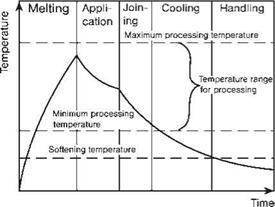Hot melts meet the criteria ofadhesion and inner strength in a unique way. They are applied from the melt that has intense contact to the surface to be bonded and thus allows adhesion to build up. After cooling, hot melts solidify and build up inner strength. Hot-melt adhesives can be categorized as: (i) physically setting adhesives, which are still thermoplastics after cooling; and (ii) chemically setting adhesives, which become thermosets (i. e. three-dimensional) networks. Both types of hot melt are liquids when applied, and solids at room temperature.
The advantages and disadvantages of hot melts compared to chemically setting and solvent-containing adhesives are summarized in Table 5.1.
Postcuring or enlargement ofthe adhesion area can relieve the problem oflimited resistance to heat.
The processing temperatures of different hot melts as a function of time are a good indication of the assessment of their fields of application (see Figure 5.7) [9].
The softening temperature induces a deformation of the hot melt; with a further increase in temperature, the adhesive is transformed into a melt (temperature interval). As soon as the melt has a sufficient viscosity, an optimum wetting of the adherent surface can take place without adversely affecting the melt. During processing, the typical viscosities of hot melts range between 20 Pa-s (polyamide) and 10 000 Pa-s [ethylene vinyl acetate (EVA) copolymers]. At processing temperature, the bond-line strength is raised with increasing melt viscosity, which in turn increases as the molar mass of the polymers rises [10]. The processing temperatures
Table 5.1 Advantages and disadvantages of hot melt adhesives.
 Disadvantages
Disadvantages
• No solvent required (being melts) • High viscosity and heat stress of the adherents
• No dosing or mixing required • Hot-melt equipment necessary
• Short setting periods • Low resistance to heat (tendency to creep at higher
• Thermally detachable bonds temperatures or sustained loading)
|
Figure 5.7 Temperatures of hot melts during the application process. |
depend on the type of base material used, and range between 120 and 240 °C; for example, high-melt systems based on polyimides have a processing temperature in excess of 260 °C. The maximum processing temperature depends on the resistance of the melt towards thermal or oxidative degradation. Thermal stability is obtained by the addition of stabilizers and anti-oxidants. When, after joining, the adhesive solidifies, the solidification rate is seen as a criterion for the mechanical ability of the joint to take stress.
5.3.1
 3 сентября, 2015
3 сентября, 2015  Pokraskin
Pokraskin 
 Опубликовано в рубрике
Опубликовано в рубрике 